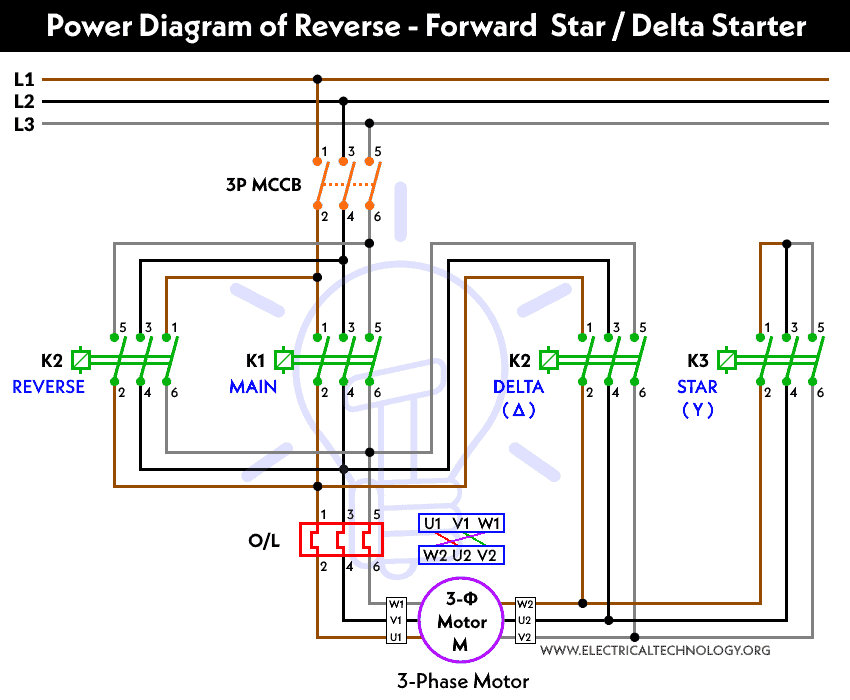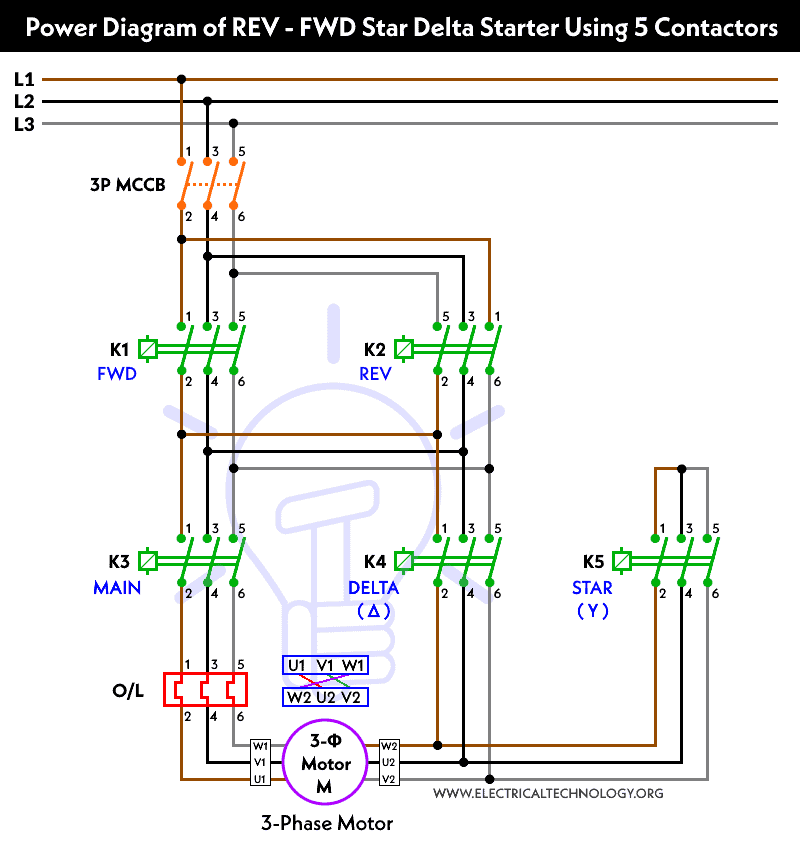Reverse and Forward Star / Delta (Y-Δ) Starter for Three Phase Motor using Timer
Three-phase induction motors are widely used in industrial applications due to their efficiency and robustness. To control the direction of rotation and reduce the starting current, various starting methods are employed. One such method is the “Reverse Forward Star Delta Starter,” a popular choice for controlling three-phase induction motors.
As we have previously discussed the starting method of a Three Phase Motor using the Star Delta Starter with a timer, including power, control, and wiring circuit diagrams.
In today’s post, we will illustrate how to automatically control the motor’s rotation in two directions, namely forward and reverse, using the Star Delta Starter and timer. The timer circuit is responsible for controlling the direction of rotation of this three-phase motor, transitioning it from FWD to REV and from Star to Delta configuration.
Components Needed
- 3-Phase Motor
- MCCB – 3-P, 400V
- MCB – 2-P, 100-230V
- Contactors
- Timer
- ON OFF Push Button
- Indicators and Pilot Lights
- 230V Single Phase AC Supply
- 400V – Three Phase AC Supply
- Wires and Cables
Wiring, Power & Control Diagrams
Schematic Wiring Diagram 1
Power Diagram 1
Schematic Wiring Diagram 2
Power Diagram 2
Control Circuit Diagram
Control Wiring Diagram
Click image to enlarge
Control Circuit
The control circuit consists of various relays, timers,, pushbutton, indicators and contactors that provide the logic and switching required for the starter’s operation. It ensures that the star-delta and REV/FWD switching occurs correctly and provides additional protection features.
In the above wiring and control diagram:
- 3-P MCCB is used to protect the combination of star delta and reverse / forward starter circuit from overload and short-circuit.
- 2-P MCB is used to protect the control circuit.
- The main contactor “K1” is used to operate the motor in normal i.e. forward direction.
- The contactor “K2” is used to runs the motor in reverse direction.
- The contactor “K3” is used to operate the motor in star connection.
- The contactor “K4” is used to runs the motor at full load voltage in delta configuration.
- The timer is responsible to transfer the motor connection from star to delta after reaching to the preset value.
- The “O/L” is used to protect the motor from thermal overload protection.
- The pushbuttons are used to ON/OFF or operate the motor in REV or FWD directions
- The indicators lights are used to indicates the Trip (overload), FWD, REV or Stop position of the motor.
Working Principle
The Reverse Forward Star Delta Starter is designed to control the direction of rotation of a three-phase motor by first starting it in a reduced voltage configuration and then switching to the full voltage configuration for normal operation. The starting process involves two stages: the star configuration and the delta configuration.
Star Configuration
During the initial starting phase, the motor is connected in a star configuration. In a star configuration, the motor windings are connected in such a way that each winding’s starting end is connected to the ending end of another winding.
The other end of each winding is connected to a common point, forming a star-like shape. By doing so, the voltage applied to each winding is reduced to approximately 1/√3 times the line voltage, significantly reducing the starting current and preventing excessive torque on the motor shaft.
Delta Configuration
After the motor reaches a certain speed, the control system switches the motor’s connection from star to delta. In the delta configuration, the motor windings are rearranged in a closed-loop or delta shape.
This reconfiguration results in applying the full line voltage across each winding, allowing the motor to run at its rated speed and torque.
Reverse Forward Operation
The Reverse Forward Star Delta Starter provides a method to reverse the motor’s direction of rotation. When the motor needs to rotate in the reverse direction, the system switches between the star and delta configurations but in reverse sequence.
Good to know: Please be aware that we have changed the phase sequence for the reverse (REV) contactor. Specifically, the forward (FWD) contactor is connected to the main supply via L1, L2, L3 (Brown, Black, Gray), while the reverse contactor is connected via L3, L2, L1 (Gray, Black, Brown).
Similarly, in the case of the second wiring with 5 contactors, the forward contactor is connected to (1,3,5), and the reverse contactor is connected to (5,3,1). As a result, the motor will now run in reverse due to the change in the phase sequence.
Construction of Reverse Forward Star Delta Starter
The Reverse Forward Star Delta Starter consists of several components that work together to control the motor’s starting process and direction of rotation. The main components include:
Main Contactors
The main contactors, “K1 as FWD” and “K2 as Reverse,” are heavy-duty relays that control the connection between the motor and the power supply. They are responsible for switching the motor between the star and delta configurations, as well as for changing its direction between forward and reverse.
Star Delta Contactors
“K3 and K4” are used as Delta and Star contactors, respectively. They are responsible for initially running the motor in the star connection at low voltage and later switching to full load voltage when the timer reaches the preset value.
Star-Delta Timer
The star-delta timer is an essential element of the motor’s starter. It determines the duration for which the motor operates in the star configuration before switching to the delta configuration. The delay allows the motor to gain sufficient speed and avoid sudden changes in torque during the transition.
Thermal Overload Relay
The thermal overload relay is a protective device that monitors the motor’s current and protects it from overheating during operation. If the motor draws excessive current, indicating possible overloading, the thermal overload relay trips and disconnects the motor from the power supply.
Push Buttons
The start and stop buttons allow the operator to manually initiate or halt the motor’s operation. These buttons are typically located on a control panel within easy reach of the operator. Additionally, the FWD and REV pushbuttons can be used to manually change the direction of rotation of the motor while it is still in star-delta mode.
Indicators
Four indicators, acting as pilot lights, are used to indicate the tripping, overload, forward, reverse, and Start/Stop positions of the motor.
Advantages of Reverse Forward Star Delta Starter
The Reverse Forward Star Delta Starter offers several advantages over other starting methods:
- Reduced Starting Current
One of the significant advantages of this starter is the reduced starting current in the star configuration. By starting the motor with a lower voltage, it draws less current during the starting phase, minimizing stress on the motor windings and the power supply.
- Smooth Transition
The star-delta transition provides a smooth changeover from reduced voltage (star) to full voltage (delta) operation. This results in a gradual increase in torque and minimizes mechanical shocks, enhancing the motor’s reliability and longevity.
- Reversibility
The ability to reverse the motor’s direction of rotation is crucial in various industrial processes. The Reverse Forward Star Delta Starter offers a simple and effective method to achieve motor reversal without the need for additional complex circuits.
- Cost-Effectiveness
Compared to other advanced motor starting techniques, the Reverse Forward Star Delta Starter is relatively cost-effective. It strikes a balance between the cost of the starter and the performance benefits it offers.
Applications
The Reverse Forward Star Delta Starter is commonly used in various industries and applications, including:
- Conveyor systems
- Pumps and compressors
- Fans and blowers
- Machine tools
- Material handling equipment
Related Posts:
- Three Phase Motor Star/Delta Reverse & Forward without Timer
- Reverse-Forward of 3-Phase Motor – Wiring, Power & Control Circuit
- Automatic Reverse Forward Motor Control Circuit Using Delta – DVP-14SS PLC
- Automatic Reverse – Forward Motor Control Circuit Using Omron CP2E PLC
- Reverse Forward Motor Control Circuit Using PLC – ZEN Programming Relay
- Reverse Forward Motor Control Circuit Using Mitsubishi FX Series PLC
- Automatic Reverse Forward Motor Control Using S7-1200 PLC
- STAR-DELTA Starter Motor Starting Method Without Timer
- Automatic Star-Delta Starter using Timer – Power, Control & Wiring Diagrams






 Why is the Long Prong Neutral Instead of the Narrow Prong?
Why is the Long Prong Neutral Instead of the Narrow Prong? Why is the Neutral Prong or Slot Wider on a Plug or Outlet?
Why is the Neutral Prong or Slot Wider on a Plug or Outlet? Why are there Grooved Slots in the Pins of Two Pin Plugs?
Why are there Grooved Slots in the Pins of Two Pin Plugs? How to Size a Branch Circuit Conductors with Protection?
How to Size a Branch Circuit Conductors with Protection? How to Size Feeder Conductors with Overcurrent Protection
How to Size Feeder Conductors with Overcurrent Protection How to Size Service-Entrance Conductors and Feeder Cables?
How to Size Service-Entrance Conductors and Feeder Cables?